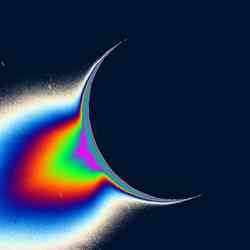
Saturn’s moon Enceladus. Image credit: NASA/JPL/SSI Click to enlarge
Now that Cassini has uncovered how Enceladus is spewing out water ice from geysers at its southern pole, scientists have an explanation for Saturn’s E ring. This is Saturn’s outermost ring, which consists of a diffuse cloud of particles stretching from Mimas to Titan. Cassini’s magnetometer matched the signature of the ice geysers to the particles in the E-ring, linking one to the together.
Saturn’s moon Enceladus is the source of Saturn’s E-ring, confirms research published today.
Writing in the journal Science, scientists show how a plume of icy water vapour bursting out of the South Pole of Enceladus replenishes the water particles that make up the E-ring and creates a dynamic water-based atmosphere around the small moon. The E-ring is Saturn’s outermost ring and is composed of microscopic particles. It is very diffuse and stretches between the orbit of two of Saturn’s moons, Mimas and Titan.
Scientists discovered the dynamic atmosphere during three separate fly-bys of Enceladus by the Cassini spacecraft in February, March and July 2005. Cassini Huygens is a joint NASA/ESA mission to study the Saturnian system.
The team working on results from the magnetometer instrument were surprised to discover what they believed was an atmosphere on their first fly-by, 1176km from the moon’s surface. After a second flyby at 500km confirmed their observations, they persuaded the Cassini Project to take the next flyby much closer to Enceladus in order to investigate further.
On this flyby, at 175km, measurements from all the different instruments on the spacecraft confirmed the presence of an atmosphere. Later remote sensing observations of the moon revealed a plume of water vapour coming from the moon’s South Pole.
The atmosphere was also seen to change between the flybys, with a particularly extended atmosphere observed during the first one and a more concentrated atmosphere seen during subsequent flybys. The team believe that changing levels of activity by the plume at the South Pole were causing these changes in the atmosphere.
Professor Michele Dougherty, from Imperial College London’s Department of Space and Atmospheric Physics, Principal Investigator on Cassini’s magnetometer instrument and lead author of one of the papers, said: “When we observed signatures of an atmosphere on the first distant flyby we were very surprised because it was so unexpected to observe such signatures so far away from the moon.
“It was extremely exciting to have all the other instruments confirm our initial discovery, particularly when it was found that the atmosphere was changing from flyby to flyby and was closely linked with the subsequent plume observations at the South Pole. In addition this discovery clearly shows the importance of having a multi-instrument spacecraft such as Cassini since it enables us to combine a whole range of different data sets thereby allowing us to gain a much better overall understanding of complex physical systems.
Measurements of the temperature of Enceladus showed that, surprisingly, there is a concentration of heat around the South Pole, with the hottest point located over one of the fractures in the planet’s surface. The scientists believe that this heat signature shows internal processes within Enceladus causing the icy plume, by heating the moon’s ice.
Original Source: PPARC News Release
